Within the last decade, RB Salzburg were the most dominant team in Austria and also qualified last season for the 2019/20 UEFA Champions League campaign(the first time an Austrian side was able to do so since Austria Vienna in 2013/14). However, within the last two years, LASK Linz became a serious challenger for the team of Jesse March.
Before Linz were able to really challenge the best team of Austria, the two capital clubs, Rapid Vienna and Austria Vienna, were always the teams who were sometimes able to offer competition to RB Salzburg.
In this recruitment analysis, we will look at LASK Linz’s activity on the transfer market within the last years to investigate how important the recruitment is for their success.
Development in the last years and overview
Before we now look at the statistics of their recruitment of the last seasons, we need to look at their performances to evaluate in which time it makes sense to analyse their activity on the transfer market.
Therefore, I visualised in the graph below their rankings within the last couple of seasons. Please note that the colours of the bars stand for the league level as blue (2012/13 and 2013/14) is the third Austrian division, green (2014/15 until 2016/17) is the second tier and red (2017/18 until today) is the Austrian Bundesliga. Additionally, I took for the current season which will restart in one week their position after the opening 22 matchdays.
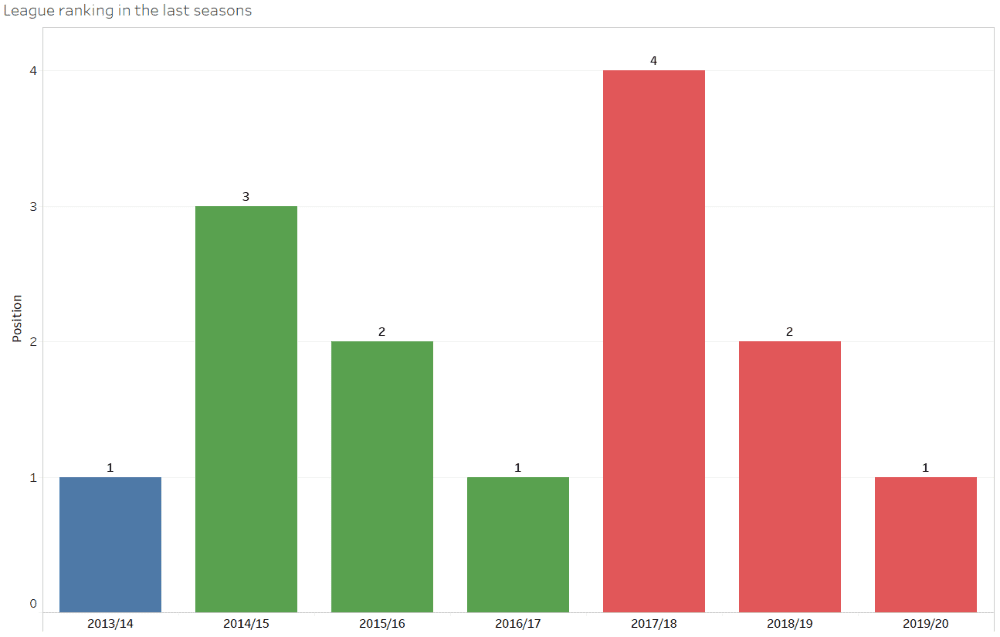
We can perfectly see that they developed from year to years and always had a better final ranking than in the prior season. However, since The transfer activity of a club in the second league is different compared to one in the Austrian Bundesliga and because of this we would get mixed results if we look at the statistics for the last five years (for example), we will focus on their transfers from the summer transfer window of the season 2017/18 until to the winter transfer window of the current campaign.
In the following, when we talk about their arrivals, we won’t include the players who return from a loan since these are in truth no new arrivals. Also, I used the data of Transfermarkt and I need to note here that there will be some players who were signed by LASK Linz and then moved to their second squad (Juniors OÖ). Also, there are several players who officially joined LASK from their second squad, but in truth still, only play for Juniors OÖ. In the first part of this recruitment analysis, we will include them in the statistics, but when we have a more detailed look at their current squad, we will see who really plays in the first team.
In the graph below, we can see the basic overview of their arrivals within the last three seasons.
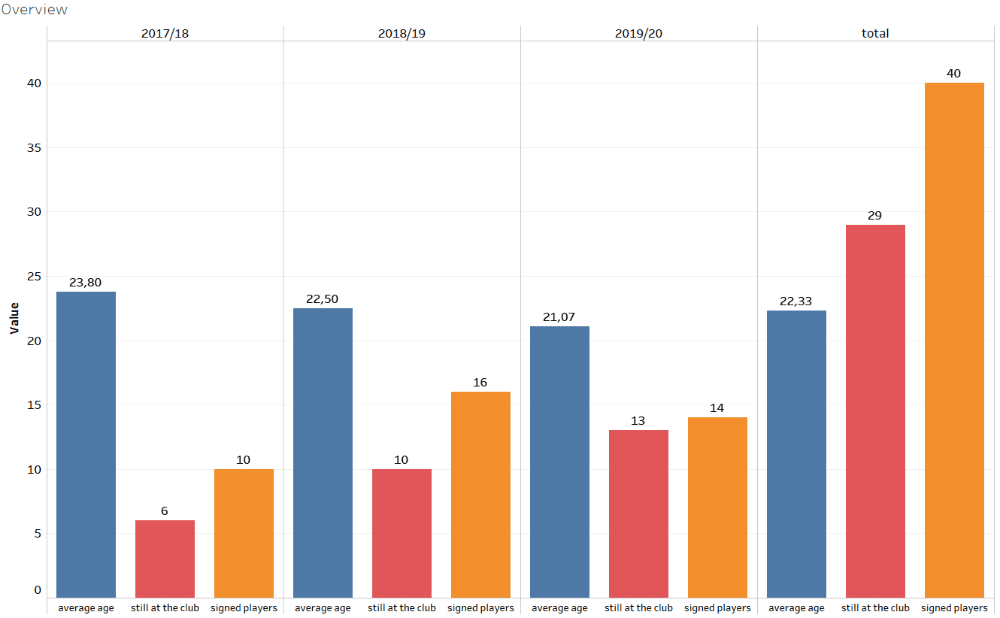
The first aspect which immediately stands out is that the value for the average age of the players (at the moment when they arrive) is quite low. The 40 signed players (35 on a permanent deal and five on loan) have overall an average age of 22.33 years. Also, the fact that 29 of the 40 players are either part of the first team or play for Juniors OÖ is a good number.
Considering this, at the first glance we can see that LASK Linz have a quite effective transfer strategy and sign a lot of young talents who should then either pick up some time on the pitch in the second team or get instantly implemented in the first squad.
Next, we will have a look from which countries the players join them as we can see in the graph below.
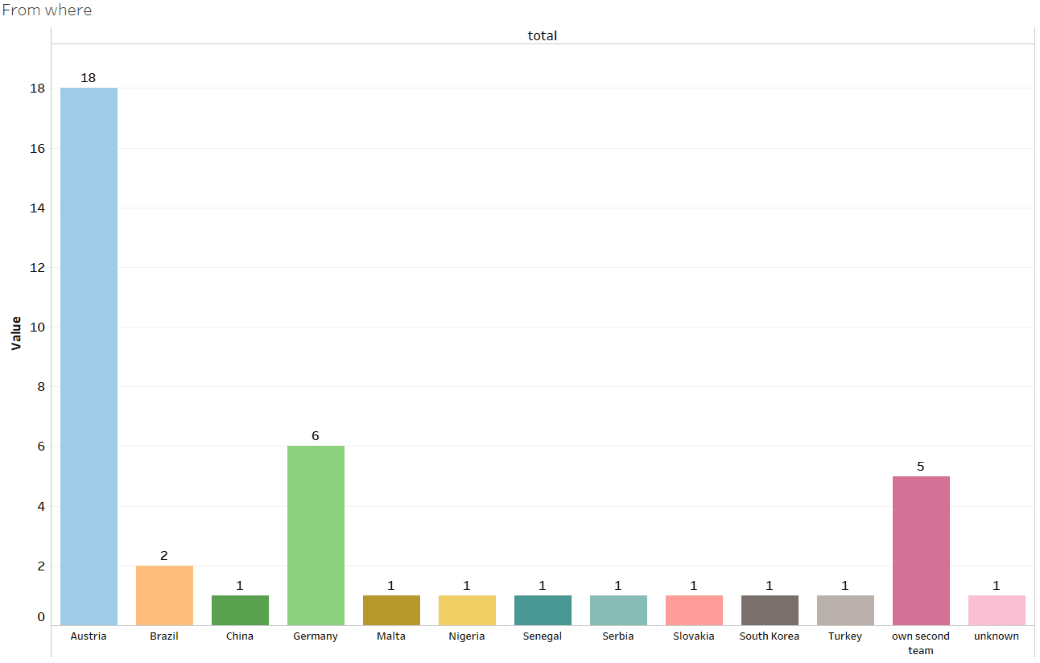
The next obvious aspect of their transfers is that they mainly bring in players from Austria or Germany what is typical for all clubs in Austria except RB Salzburg who often sign talented players like Noah Okafor from Basel or Antoine Bernede from Ligue 1 giants PSG.
Anyways, LASK Linz haven’t got the financial power like their rival and due to that, they focus on signing the best players in Austria and also some young men from Germany. The statistic with the five players from their second side is not completely true as Marko Raguž is out of these five players the only regular starter for LASK.
The huge advantage when you sign players from Austria is that they usually already speak German (same case of course for players from Germany) and additionally are used to the level of play in Austria.
Current squad
Now, we will look at some statistics regarding to the current squad of LASK Linz to see the actual result of the recruitment process within the last seasons.
First of all, we want to know who the most important players are, how many minutes they played in this season, when they arrived at the club and furthermore get a first overview over their (current) age. All these facts can be found in the graph below. Notice, that I excluded players who played in this season less than 100 minutes (only young men from the second squad or young new arrivals did so). Also, the players with a cross missed at least five games due to injuries.
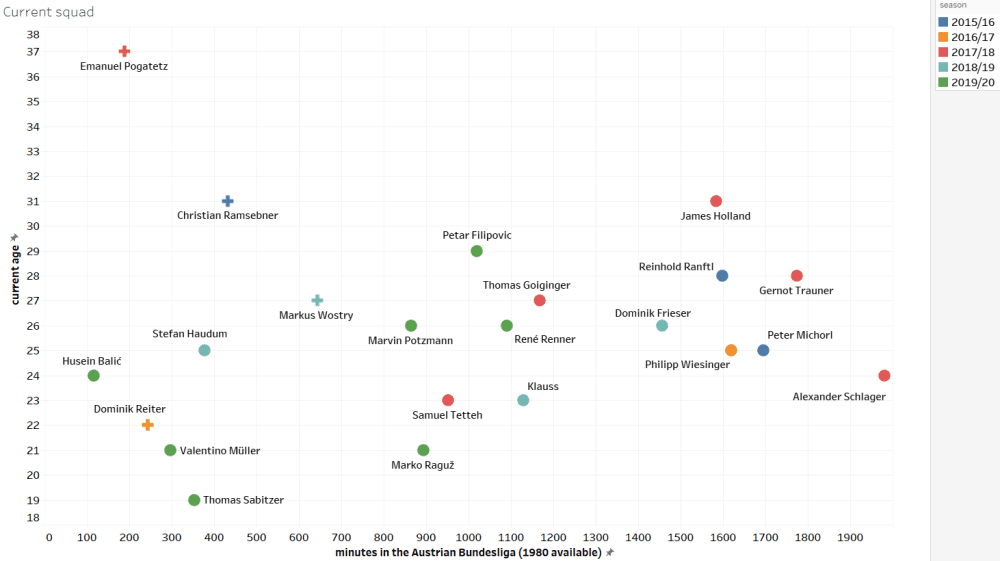
We can see that the most important players are all between 24 years old and 31 years old. Therefore, the majority of their players are currently at their peak or are getting there. Also, no player was part of the team ahead of the season 2015/16 what is logical as the level and ambitions of the team completely changed since them. Also, we can see that there is a good mixture between players who are already there for a longer time (Peter Michorl and Reinhold Ranftl) and men who arrived in the current season (Petar Filipovic and René Renner).
Also, we now see what I mentioned earlier in this recruitment analysis as Raguž is the only player in this graph who was in the second squad and own youth before he became part of the first team.
Next, we have a more detailed look at the age of the players as we can see in the graph below.
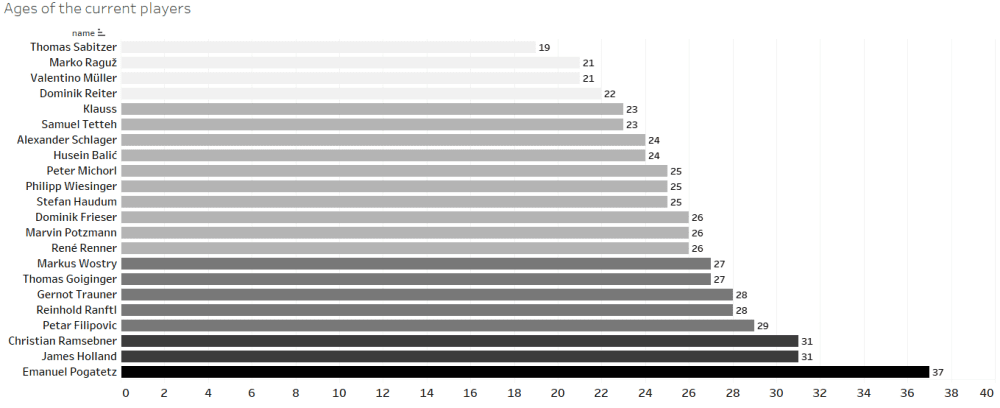
I need to note again that here we only have the players who played in this season at least 100 minutes. There are still some other interesting players in the squad like Tobias Lawal (19-years-old goalkeeper), David Schnegg (21-years-old left-back) or Andrés Andrade (21-years-old winger) who could probably become more time on the pitch in the upcoming season, but currently are either back-ups or paly for the second squad.
Basically, we see again that the majority of the players iare between 23 and 30. In this time, players often perform at their highest level and additionally we can see that most of them are under 27 which means that they have several good years to come.
Financial analysis
In this last and final part of this recruitment analysis, I want to talk a bit about the money which they spent and earned within the last three seasons. So, as in the first part of this analysis, we again take the numbers from the summer of ahead of the season 2017/18 until to the winter transfer window in this year’s January.
In the first graph, we see how many money they spent on new players each season and how many they earned by selling. At this point, I need to add that for those transfers for which no transfer fee is officially known, I assumed that these were free transfers. Due to that, the numbers could be slightly higher, but since this is mainly the case when it comes to transfers of younger more unknown players, the fees won’t be that high. Also, all numbers in the following graphs are in million £.
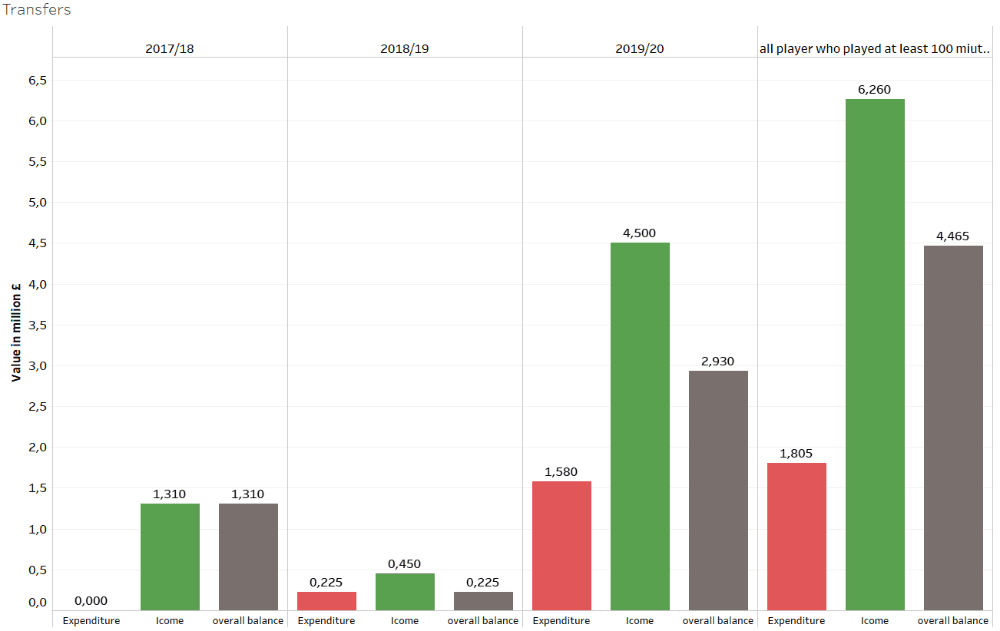
Basically, we can clearly say two things after looking at this graph since firstly that they had every season more income than they spent on new players and secondly that the money which they earned and spent increased from year to year. That’s logical since they had every season a better squad which performed on a higher level (therefore the players had a higher market value) and due to that, they needed to spend more to replace them equally.
Anyways, just by looking at the numbers above, we can see how intelligently they bought and sold players within the last three seasons.
Now, as the last point of this recruitment analysis, we will again take the players who were in this season in the Austrian Bundesliga at least 100 minutes on the pitch and see how many LASK paid for them, how high their market value was back then and how high it is now. These numbers are visualised in the following graph.
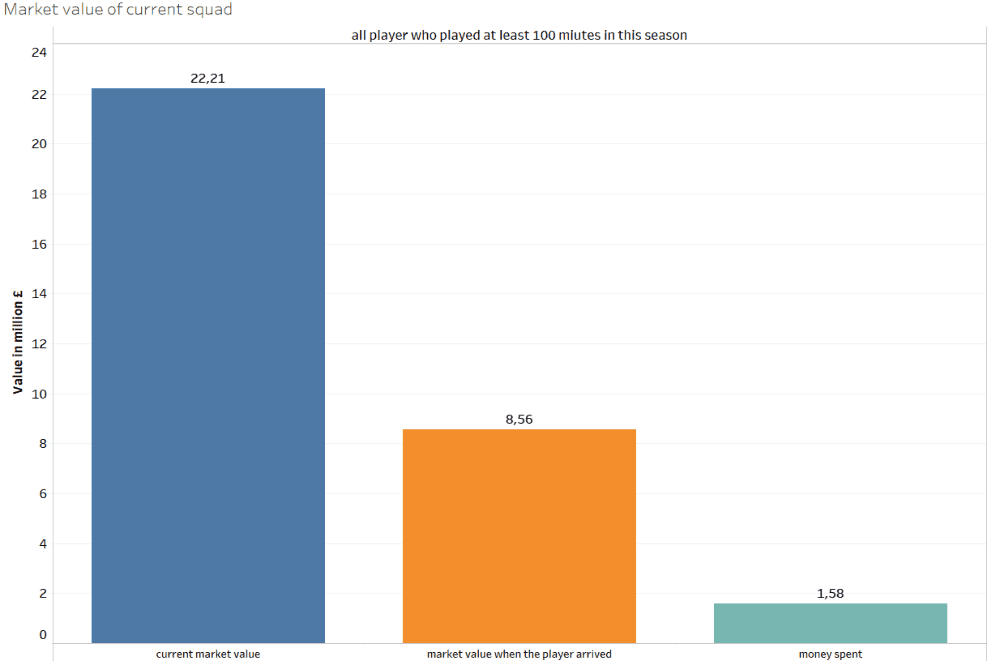
In this image, we can probably see the most outstanding aspect of their transfer activity within the last couple of years. Considering this, they spent within the last seasons combined 1.58 million £ for their current most important players and these 22 men with at least 100 minutes have currently a combined market value of 22.21 million £ and you have to consider that they would be even higher without the corona crisis. Also, again I didn’t include the players from their own second team (except Raguž) and those who played less than 100 minutes respectively.
Conclusion
Of course, also LASK Linz signed within the last few seasons players who weren’t able to settle in and were flops, but overall you have to give them huge credit for their incredible transfer strategy as we saw in the several statistics.
Their recruitment process helped them massively within the last seasons to become one of the best sides in Austria. No matter in which position they finish this season, we will probably see some of their players leaving for a bigger club, but they will likely replace them well once more.



Comments